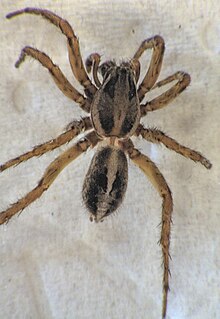
Wolf spiders are members of the family Lycosidae, from the Ancient Greek word "λύκος" meaning "wolf". They are robust and agile hunters with excellent eyesight. They live mostly in solitude and hunt alone, and do not spin webs. Some are opportunistic hunters pouncing upon prey as they find it or even chasing it over short distances. Some wait for passing prey in or near the mouth of a burrow.
Nukuhiva is a genus of spiders with a single species, Nukuhiva adamsoni, that occurs only on the Marquesas Islands in French Polynesia. It is in the wolf spider family, Lycosidae. It has been found on Nuku Hiva and on Ua Huka, a smaller island about 25 km (16 mi) to the east.

The Artoriinae are a subfamily of wolf spiders. The monophyly of the subfamily has been confirmed in a molecular phylogenetic study, although the relationships among the subfamilies was shown to be less certain.

Artoriopsis is a genus of wolf spiders first described by Volker W. Framenau in 2007. They are endemic to Australia and are most diverse in the southern half of the continent, though A. anacardium is found in the tropical north of Australia. Their body size ranges from 3 to 11 mm, with males smaller than females. They appear to prefer open, vegetated or sandy areas of moderate humidity.

Arkyidae is a family of araneomorph spiders first described by Ludwig Carl Christian Koch in 1872 as a subfamily of Araneidae, and later elevated to a full family in 2017.
Agalenocosa is a genus of spiders in the family Lycosidae. It was first described in 1944 by Mello-Leitão. As of 2017, it contains 18 species with a wide distribution.
Artoria is a genus of spiders in the family Lycosidae. It was first described in 1877 by Thorell. As of 2017, it contains 32 species.
Costacosa is a genus of spiders in the family Lycosidae. It was first described in 2013 by Framenau & Leung. As of 2017, it contains 2 species, both from western Australia.
Dingosa is a genus of spiders in the family Lycosidae. It was first described in 1955 by Roewer. As of 2017, it contains 6 species from Australia and from South America.

Hoggicosa is a genus of wolf spiders first described by Carl Friedrich Roewer in 1960. The name is a reference to arachnologist Henry Roughton Hogg.
Knoelle is a genus of spiders in the family Lycosidae. It was first described in 2006 by Framenau. As of 2017, it contains only one species, Knoelle clara.
Mainosa is a genus of spiders in the family Lycosidae. It was first described in 2006 by Framenau. As of 2017, it contains only one species, Mainosa longipes, found in Australia.
Tapetosa is a genus of spiders in the family Lycosidae. It was first described in 2009 by Framenau et al.. As of 2017, it contains only one species, Tapetosa darwini, found in western Australia.
Tasmanicosa is a genus of spiders in the family Lycosidae. It was first described in 1959 by Roewer. As of 2017, it contains 14 species, all from Australia.

Tetralycosa is a genus of Australian spiders in the family Lycosidae first described by Roewer in 1960, later revised by Framenau & Hudson to include thirteen species. Genetic studies show that these spiders all diverged from a common ancestor who likely wandered into the salty area and remained. They live exclusively in certain saline environments of Australia's interior, including coastal beaches, mound springs, clay pans, and salt lakes. There haven't been enough studies to establish a conservation status, but some species have only been found in solitary salt lakes, suggesting that the increase of mining, agriculture, recreational, and similar disturbances of these unique ecosystems may eventually lead to their extinction if not properly regulated.
Tuberculosa is a genus of spiders in the family Lycosidae. It was first described in 2006 by Framenau & Yoo. As of 2017, it contains 4 Australian species.

Venatrix is a genus of wolf spiders first described by Carl Friedrich Roewer in 1960.
Venonia is a genus of spiders in the family Lycosidae. It was first described in 1894 by Thorell. As of 2017, it contains 16 species.
Portacosa is a genus of wolf spiders containing the single species, Portacosa cinerea. It was first described by V. W. Framenau in 2017, and is only found in Australia.

Venatrix furcillata, one of the wolf spiders, is a mid sized spider found in eastern Australia. The body length of the female is up to 13 mm, the male 9 mm. The abdomen has distinctive tapering markings. Sometimes noted in suburban gardens and lawns. It lives in a simple burrow, but may be seen migrating in large numbers to a communal web, an unusual feature for wolf spiders. The grey coloured spherical egg sac is around 6 mm in diameter, carried by the female. Eggs are 45 to 60 in number, 0.8 mm in diameter. Prey is ground dwelling insects. The spider has been identified as occurring in Queensland, New South Wales, and Victoria.






